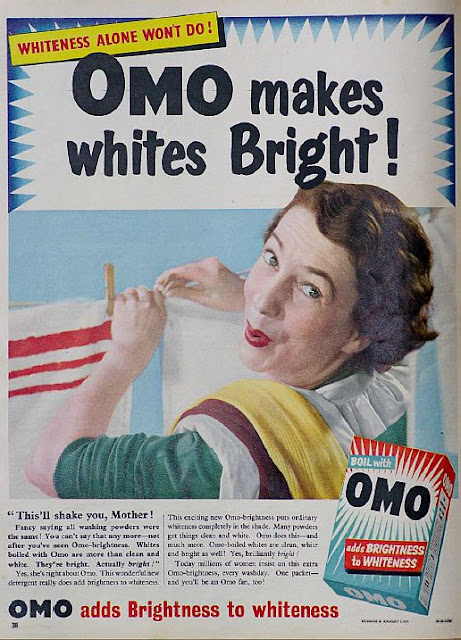OMO advert: blog tasks
1) What year was the advert produced?
The year of when this advert was produced was in 1950's.
2) How were women represented in most adverts in the 1950s?
Women were represented during the 1950's as the people who looked after the kids and who did the laundry while the men's went to work.
3) How does the heading message ('OMO makes whites bright') and typography promote the product?
2) How were women represented in most adverts in the 1950s?
Women were represented during the 1950's as the people who looked after the kids and who did the laundry while the men's went to work.
3) How does the heading message ('OMO makes whites bright') and typography promote the product?
It connotes that if you use our product (washing powder) it will make you clothes instead of just white. It will make it bright which means that if will practically shine and glow.
4) Analyse the mise-en-scene in the advert (CLAMPS): how is costume, make-up and placement of the model used to suggest women's role in society?
It connotes that the women's in society are the ones that do the clothes, washing and cooking.
5) Why is a picture of the product added to the bottom right of the advert?
The reason why they show an image of the product is because if the consumers like what they see they would want to see how the product looks like and then go to store's and get it. Also the reason why they put the image of the product at the bottom right is because its the only place to put it it because if you for example, put the image at the top left it will cover there slogan 'whiteness wont do alone' plus its the only place to put the image because there is no text in the bottom left corner.
6) What are the connotations of the chosen colours in this advert - red, white and blue?
The colour blue connotes calmness and relaxation whereas for the red it suggests beauty and that it stands out. But for white it connotes brightness and cleanness (reinforces MACHES COLOUR product claim).
5) Why is a picture of the product added to the bottom right of the advert?
The reason why they show an image of the product is because if the consumers like what they see they would want to see how the product looks like and then go to store's and get it. Also the reason why they put the image of the product at the bottom right is because its the only place to put it it because if you for example, put the image at the top left it will cover there slogan 'whiteness wont do alone' plus its the only place to put the image because there is no text in the bottom left corner.
6) What are the connotations of the chosen colours in this advert - red, white and blue?
The colour blue connotes calmness and relaxation whereas for the red it suggests beauty and that it stands out. But for white it connotes brightness and cleanness (reinforces MACHES COLOUR product claim).
7) How does the anchorage text use persuasive language to encourage the audience to buy the product? Give examples.
It persuades the consumer because of using far fetched words. For example, at the start of the the anchorage text the is says "this'll shake you, mother!" which connotes that who ever uses the washing powder the brightness of it will shake you.
8) What representation of women can be found in this OMO advert? Make specific reference to the advert and discuss stereotypes. It connotes that women's are the one who do the laundry and make sure everything stays clean in the house.
9) What is the preferred reading for this advert - what did the producers of the advert want the audience to think in 1955?
That during that time period while men were at work women's will be the one who would've done the work in the house.
10) What is the oppositional reading for this advert - how might a modern audience respond to this text and the representation o f women here?
They would respond to it in a negative way because NOW men and women go to work and they both do the laundry and house work. Not only women's like it was during 1955.


Comments
Post a Comment